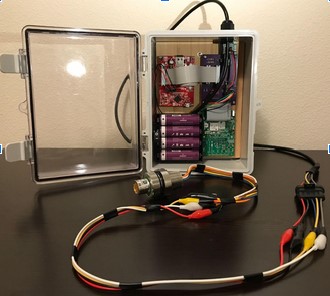
Air quality is very important for safe working conditions. In every indoor space
there should be a monitoring system for environmental risks and air pollutants such
as CO2 and fine particulate matter (PM2.5), as well as ventilation rates. Our team’s goal was to build a device to monitor elevated or dangerous quantities of these pollutants using as many commercial off-shelf components and open-source software as possible. Our aim was to create 3 to 10 wireless, battery powered initial prototypes that each have at least one year life span. This project is sponsored by the Wireless Environmental Sensor Technologies (WEST) Lab in the Electrical and Computer Engineering Department at Portland State, run by Dr. David C. Burnett. The faculty advisor is Dr. John M. Acken.
This Project will be improving on the project from spring of 2022 to report readings of carbon dioxide and particulate as well as airflow instead N2O in an indoor environment instead of an outdoor environment.
The team was successful in the project. We completed the project with 4 work-
ing nodes that communicate with each other using SmartMesh IP. The units can achieve a battery life of a year with reasonable capture times. Each unit is also equipped with the SGP30 CO2 sensor and SPS30 PM2.5 sensor to collect data. The system is housed in a cut acrylic box that can be mounted on walls or ceilings.
Industry Sponsor : Dr. David Burnett (Principal Investigator of WEST Lab at Portland State University)
Faculty Advisor: Dr. John M. Acken
Engineers:
Adam A. Dezay
Manuel A. Garcia
Brandon P. Hippe
Mercedes C. Newton
Customer: Any business or person in need of monitoring changing air quality conditions.
The sensor system must:
Produce a fully wireless sensor data logger incorporating as many open-source components as possible and able to be produced at a very low cost. A particular goal of this project is very low power performance: sensors, communication system, and the microcontroller should be in as low a power state as possible when not in use such that batteries need to be changed, at most, annually. (The lifetime of a smoke detector would be even better!)
Data should be temporarily logged locally and wirelessly communicated to base station(s) as appropriate. A stretch goal includes visualization dashboard to present the logged data graphically for at-a-glance use. The device should be mechanically integrated into as small a form-factor as is practical and contained in a robust housing appropriate for indoor environments.
This project used some of the research done in last year capstone project. The final report from previous project can be found under the documentation folder in the team Github repository. The file is titled Team 13 - Final Report - SensorSuit - 2.pdf. Link to the Github can be found in the project resources section
Even Though the project from last year measured temperature, humidity, and N2O outdoors, both projects share the same controller, the MSP430. They both also use SmartMesh IP as a way to connect multiple nodes.
We faced many challenges with the microcontroller as well as SmartMesh that last year team did not experience. Check Appendix A in the final report to see the solutions to unexpected problems we encountered that the previous team did not.
